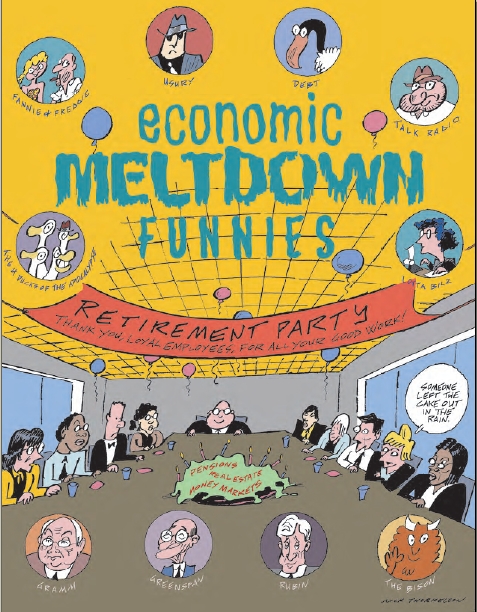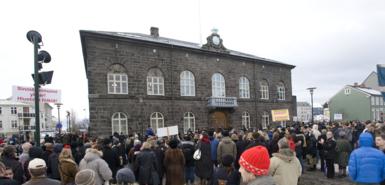You are currently browsing the category archive for the ‘Economic Crisis’ category.
More and more comparisons between today’s market plunge and the Great Depression of 1930s are being made and are needed. This article from Monday favorably compares the collapse of the Dow Jones Industrial Average, the most important measure of industrial economic activity.
It’s interesting to note that Phil Dow, “market strategist for RBC Dain Rauscher & James” admits the possibility that we are witnessing “the end of capitalism.” He denies that this is the case, since “people will start buying cars [and houses] again“. He’s trying to be optimistic of course, but it’s hard to imagine anything more depressing, considering that members of the UN Intergovernmental Panel on Climate Change (IPCC) are now warning that greenhouse gas emissions are rising much more rapidly than their worst-case projections.
A new way of life is on its way that does not rely on consuming ever-increasing mountains of industrial products, and that’s cause for celebration. [alex]
Dow Jones decline rate mimics Great Depression
by Dawn Kawamoto
Originally published by CNET, March 2, 2009.
With the Dow Jones Industrial Average falling below the psychological watermark of 7,000 on Monday, investors may be wondering how it all stacks up against the stock market crash of the Great Depression.
It’s not looking good.
In the here and now, the Dow has dropped 52.5 percent since its high of 14,279.96 on Oct. 11, 2007, to its low point of 6,779.62 during intraday trading on Monday. (Update 1:16 p.m. PST: At Monday’s close it was 6,763.29, a drop of nearly 300 points from the previous close.)
And in taking a similar period of a year and five months in the late 1920s, it’s a case of deja vu.
The rate of decline is mimicking that of the Dow during the Great Depression.
Back on September 3, 1929, the Dow hit a high mark of 381.17. And over a similar length of time, it fell 54.7 percent to 172.36 on January 2, 1931.
“It’s very troubling if you have a mirror image,” said Phil Dow, market strategist for RBC Dain Rauscher & James. Read the rest of this entry »
Anatoly Karlin at Sublime Oblivion has compiled some provocative graphs which suggest that the global peak of oil production has played a large causative role in the global economic meltdown of the past few years. Right off the bat we should look at how skyrocketing oil prices caused global food shortages and price inflation for other necessities, but also how the rising gas prices hurt US Real Estate markets and burst the subprime mortgage bubble. We know how that damage was compounded into the financial crisis and got us where we are, but what hasn’t been studied is the role of oil in originating the breakdown, not to dismiss the role played by lax regulatory oversight, financial mismanagement or straight-up theft by large banks and speculators.
I look forward to this argument on the role of oil being expanded and enriched by an anti-capitalist framework. [alex]
Excerpts from Oily Origins of the Economic Crisis.
Anatoly Karlin, February 18, 2009.
In an article some months ago I suggested that “perhaps this crisis is simply an unconscious recognition of this inconvenient truth?” – namely, the peaking of oil extraction and all that it implies for the continued survival of a financial system built on assumptions of continuous economic growth. In other words, the fashionable approach of focusing on exotic financial instruments, regulatory failures, etc, if a case of mistaking the forest for the trees.
The Oil Drum had a nice graphical summary. According to the author, Gail the Actuary, the chain of causation runs thus:

This explains the extreme severity of the crash – record GDP growth at a time of plateaued oil extraction in the 2005-2008 period was patently unsustainable, so a very big “correction” could not have been unexpected.
And it is quite a correction.
As of the September-November average, global industrial production was plummeting at an annualized rate of -13% and merchandise trade by a truly remarkable -43%. And it is obvious the collapse accelerated since then…

Already far worse than during even the worst month of 2000-2001, the last and only global slowdown for which the IMF has data.
…
Another Oil Drum blogger, Phil Hart, wrote about the dramatic rise and fall in oil prices in terms of simple supply and demand curves…

Oil demand and supply.
His thesis is that because of the geological limits to oil supply, the marginal cost of providing ever more oil is generally low until it reaches some point – say, 85mn barrels a day – and then veers off into the sky (i.e. becomes very inelastic). Demand is also inelastic, since modern society basically runs on oil. Hence there comes a time when the demand curve reaches a point when its intersection with the supply curve – i.e., the market price – starts rising exponentially. Read the rest of this entry »
One of Philadelphia’s larger newspapers puts Paul Glover, local currency and mutual aid-based health care advocate, on its cover story. As always, Paul makes wise and witty proposals to help us solve our economic and ecological woes, and now people are finally listening!
My favorite solution: “Neighborhood watch instead of neighborhood watch TV.” [alex]
Prepare for the Best
A guide to surviving — and thriving in — Philadelphia’s new green future.
Published: Jan 28, 2009
CityPaper
The Dark Season closes around Philadelphia. Wolves howl, “Tough times coming!” Young professionals with good jobs study budget cuts, watch stocks flail. Career bureaucrats are laid off; college students wonder who’s hiring. Old-timers remember when Philadelphia staggered through the terrible Depression years without jobs or dollars, while crime and hunger rose. Some districts here never escaped that Depression — they’re still choosing between heating and eating.
 |
As usual, the future will be different. Philadelphia’s responses to global warming and market cooling, high fuel and food prices, health unsurance, mortgages, student debt and war will decide whether our future here becomes vastly better or vastly worse. Whether we’re the Next Great City or Next Great Medieval Village. Imagine Philadelphia with one-tenth the oil and natural gas.
But to hell with tragedy. Let’s quit dreading news. Take the Rocky road. There are Philadelphia solutions for every Philadelphia problem.
Imagine instead that, 20 years from now, Philadelphia’s green economy enables everyone to work a few hours creatively daily, then relax with family and friends to enjoy top-quality local, healthy food. To enjoy clean low-cost warm housing, clean and safe transport, high-quality handcrafted clothes and household goods. To enjoy creating and playing together, growing up and growing old in supportive neighborhoods where everyone is valuable. And to do this while replenishing rather than depleting the planet. Pretty wild, right?
Entirely realistic. Not a pipe dream. And more practical than cynical. The tools, skills and wealth exist.
Mayor Michael Nutter foresees we’ll become the “Greenest City in the United States.” So it’s common-sensible to ask, “What are the tools of such a future?” “What jobs will be created?” “Who has the money?” “Where are the leaders?” “How will Philadelphia look?” “What can we learn from other cities?”
Some of the proposals sketched here can be easily ridiculed, because they disturb comfortable work habits, ancient traditions and sacred hierarchies. Yet they open more doors than are closing. They help us get ready for the green economy, and get there first. Big changes are coming so we might as well enjoy the ride. You have good ideas, too — bring ’em on.
As President Barack Obama says, “Change comes not from the top down, but from the bottom up.” Philadelphia’s chronic miseries suggest that primary dependence on legislators, regulators, police, prisons, bankers and industry won’t save us. They’re essential partners, but the people who will best help us are us. Read the rest of this entry »
Jobs with Justice and the Institute for Policy Studies recently released a comic book that explains the current economic crisis. It provides a decent explanation of the crisis of capitalism without using that language, and it does mention peak oil, but does not in any meaningful way explore the effect the energy crisis has had on the economy already. Regardless it’s a pretty amusing and cute piece of radical literature. [alex]
Check it out: http://economicmeltdownfunnies.org/
In a recent New Yorker piece, Naomi Klein astutely observes that “The crash on Wall Street should be for Friedmanism what the fall of the Berlin Wall was for authoritarian Communism, an indictment of an ideology.” One hopes so. The financial system’s collapse in 2008 offers a rare opportunity to question certain underlying assumptions about our state capitalist economy and its neoliberal ideology.
For the last few years I’ve been writing about neuroscience research which shows that the human brain is hard-wired for empathy, the ability to put oneself in another’s shoes. This is the discovery of the mirror neuron system or MNS, a finding some scientists believe rivals what the discovery of DNA meant for biology. The technical details showing how morality is rooted in biology, hardwired into our neural circuits via evolution rather than handed down from on high, lie beyond this article. But our understanding is increasing at an exponential rate and it’s compelling. Earlier this year, UCLA neuroscientist Marco Iacoboni’s superb book, Mirroring People (NY: Farrar, Strauss and Giroux, 2008, paper) made this important research accessible to the lay public.
However, this is not to underestimate the barriers to the public’s appreciation of these findings. At the apex of misunderstanding is the cynical, even despairing doubt about the existence of a moral instinct for empathy. From doctrines of original sin and Ayn Rand to Alan Greenspan and David Brooks, certain intrepretations of human nature have functioned to override empathic responses. In the words of famed primate scientist Frans B.M. de Waal “You need to indoctrinate empathy out of people in order to arrive at extreme capitalist positions.”
We know that cultures are set up to reward some people and disadvantage others. Capitalists maintain domination, in part, through subtly but actively creating society’s prevailing cultural norms. Antonio Gramsci’s writing reminds us that this control is achieved through the mass media, education, religion and popular culture as subordinate classes assimilate certain ideas as “common sense.” It isn’t that individual deviations don’t occur within the interstices of society but generally they don’t threaten elite control.
If we assume that the human brain or more specifically, the aforementioned mirror neuron system, is the implicit target of elite propaganda, then the current economic meltdown provides an almost unprecedented opportunity for us.
Perhaps not since the 1930s have our citizens been more skeptical of received wisdom about our socioeconomic system. That is, the carefully manufactured narrative of market capitalist identity and its assumptions about human nature are now thrown into sharp relief.
Not only has economic reality made a shambles of the canonical model of Homo economicus but robust empirical evidence offers promising alternative responses to basic questions about human nature. Parenthetically, other highly regarded cross-cultural studies reveal that the self-interested behavior predicted by the selfishness axiom simply fail to materialize and cooperation is the norm.
Of course there are also predatory and cruel urges within our nature, complete with their own neural correlates and evolutionary origins. But now we know that organizing an alternative to our vicious system of “natural” hyper-individualism will enhance the opportunity for the empathic aspect of our nature to flourish. Social historian Margaret Jacobs captures my optimism with her insight that “No institution is safe if people simply stop believing in the assumptions that justify its existence.” Therein lies both our challenge and responsibility.






Recent Comments